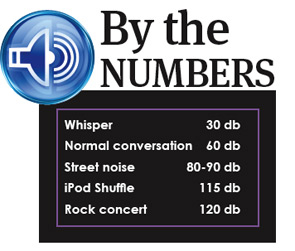To survey the effect of MP3 players, which typically use ear buds, Dr. Eavey and colleagues added questions about personal music players to their 2007 MTV survey. This time the investigators received 2,500 responses. “Hearing loss was considered a problem by 32 percent of respondents compared with other health issues such as drug/alcohol use [62 percent],” they reported (J Pediatr. 2009;155(4):550-555).
Explore This Issue
January 2010In addition, the researchers found that 75 percent of respondents owned an MP3 player, and 24 percent listened to music players for more than 15 hours per week. The researchers also surveyed how loudly respondents played their MP3 players; 45 percent of respondents indicated that they listened at 75 percent to 100 percent of volume capacity. Researchers have known that it only takes one hour of listening to an MP3 player at 70 percent of maximum volume to reach “the maximum permissible noise dose recommended by government regulation for occupational sound levels. If these were factory workers, they would be beyond [Occupational Safety and Health Administration] regulations,” Dr. Eavey said. “These kids do not have anybody punching the clock for them. There is nobody there to tell them to turn it down or off.”
In addition, 89 percent of respondents noted that if ambient sounds were loud—subway or street noise, for example—they would turn the music up to compensate. “To hear your iPod over that noise, you have to increase the volume by about 10 db [decibels] more, so that is putting it at 100 db level. Rock concerts are 120 db,” Dr. Bothwell noted.
—Ineke Vogel, PhD
The 2007 survey also found that nearly half of respondents had experienced some form of ear problems. Most had experienced tinnitus (77 percent), trouble hearing (40 percent), and ear pain (34 percent) after exposure to loud music. But despite having symptoms of hearing loss, only 15 percent used earplugs when going to concerts or clubs. The good news was that once made aware of the dangers of loud music and playing MP3 players too loudly or over long periods of time, 35 percent of respondents revealed a willingness to adopt ear protection—either earplugs or noise-canceling earphones.
A 2009 Dutch study led by Ineke Vogel, PhD, postdoctoral researcher at the Department of Public Health at Erasmus Medical Center in Rotterdam, noted that adolescents often underestimated their own vulnerability (Pediatrics. 2009;123(6):e953-e958). The investigators found that frequent MP3 player users were four times more likely to listen to high volume music than were infrequent users. “A plausible explanation for this underestimation might lie in the gradual development of hearing loss,” Dr. Vogel told ENT Today in an e-mail. In addition, her study found that adolescents “showed no understanding of how to determine which volume was too loud.”

Screening Falls Short
Most hearing tests performed in pediatrician and family practice offices are not sophisticated enough to catch the early signs of NIHL, experts said. “Even our standard hearing tests do not pick up on NIHL until it is too late,” Dr. Bothwell said. This is because the hearing loss caused by NIHL starts at the higher frequencies—16,000 hertz. “By the time you get hearing loss that is detected by most screening techniques [up to 8,000 hertz], the child is well on their way to irreversible damage,” Dr. Bothwell added.
Leave a Reply